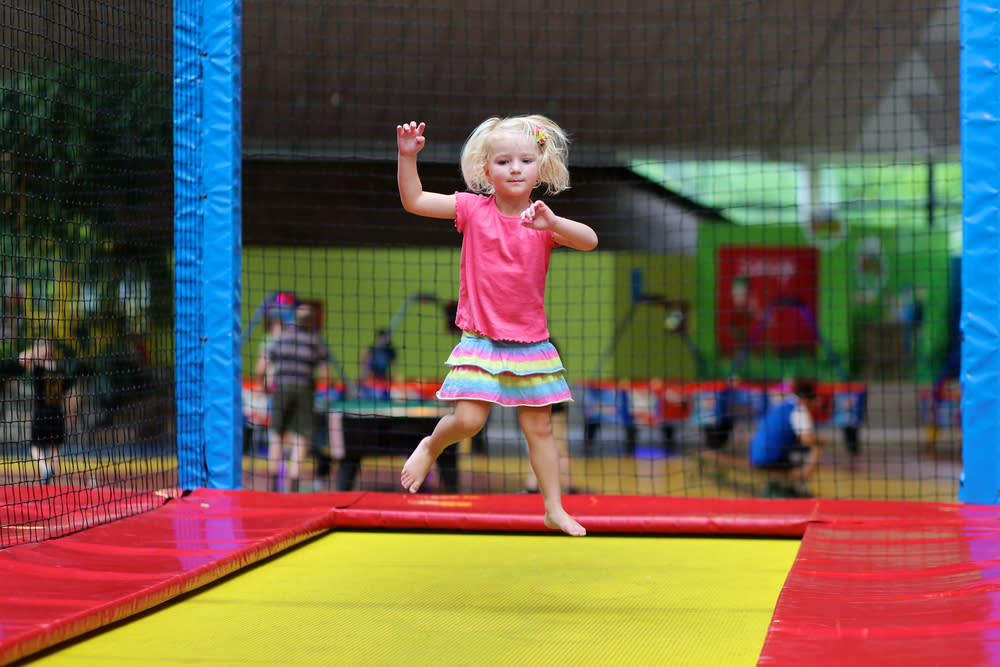More Indoor Trampoline Parks Means More Visits to the ER

Winter days can feel endless—especially if you have a house full of young kids off from school. Which is why taking your crew to an indoor trampoline park may seem like an easy way to fill time while letting your kids get some well-need exercise and—literally—bounce off the walls.
But you may want to stop and look before you let them leap. Because according to September 2016 research, as places like Sky Zone and Get Air and Stratosphere continue to gain in popularity and pop up all over the country, a surge in the number of serious injuries among children has followed suit.
That’s right. The study concluded that while injuries from home trampolines remained steady over the past four years, emergency visits from trampoline parks have gone through the roof.
"Home trampoline injuries and ER visits actually still outnumber the trampoline park injuries significantly," Dr. Kathryn Kasmire, lead researcher on the study, explained to Parents.com. "However, home trampoline emergency department visits have been steady, while trampoline park injury visits increased 10-fold—likely due to the increase in the number and popularity of trampoline parks in the last few years."
RELATED: Why My Kids Hate Me Right Now
Numbers back this up: Trampoline injuries went from 581 in 2010 (when there were only around 30 parks in existence), to nearly 7,000 in 2014 (when there were 280 parks, according to the International Association of Trampoline Parks). And considering there are currently more than 600 trampoline parks, this number has likely grown even more. In fact, a 6-year old boy broke both his ankles in January 2019 after jumping on a deflated landing zone at a trampoline park.
Children and teens accounted for most of those ER trips, with broken bones and sprains the most common injuries, followed by severe injuries like skull and neck fractures. Boys (average age 13) were more often injured than girls. And younger children were more likely to sustain a bone break, with fractures accounting for nearly half of injuries among children younger than 6.
"It's important for parents to be aware of the risks at these parks," Dr. Kasmire said, adding that the injury culprits are pretty much the same as those for home trampolines, and include things like landing wrong, contact with other jumpers, flips, falling off trampolines, and landing on the frame or springs.
Colliding with poles is also a problem at trampoline parks, which is why padding is recommended. But Dr. Kasmire cautioned that the addition of padding will not necessarily reduce injuries. Same goes for constant adult supervision, though she says you should always have it anyway.
RELATED: Are Trampolines Safe?
"The supervised environment may promote a sense of complacency and underestimation of risk at trampoline parks," she admitted. "However, dutiful supervision could be helpful to enforce trampoline park rules such as allowing only a single jumper per trampoline. Some parks have a separate designated area for young children, which could increase safety for younger jumpers because studies show that a younger child is most often the victim when multiple children are involved."
If you are planning to hit up a trampoline park, Dr. Kasmire shared with us the following suggestions:
"I recommend following the American Academy of Pediatrics trampoline guidelines, which is that children should not use trampolines," she explained. "But if they do they should have constant adult supervision, not perform flips, and only jump one at a time."
This applies to both home trampolines and trampoline parks, she said. "Parents should constantly supervise their children at trampoline parks, should not allow them to perform flips, should encourage their child not to jump on the same trampoline as another child and stay clear of other jumpers, and they should try to go when it's less crowded."
It's a lot of keep in mind for an hour or two of fun. And even after all that, Dr. Kasmire admitted that a child's safety is still not guaranteed. "While it's important to follow safety guidelines," she said, "this does not eliminate the risk of potentially serious injuries."
Hollee Actman Becker is a freelance writer, blogger, and a mom. Check out her website holleeactmanbecker.com for more, and then follow her on Twitter at @holleewoodworld.

